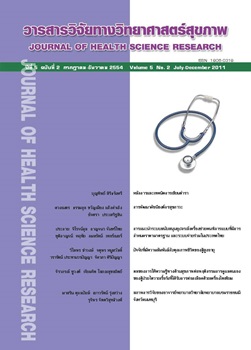Introducing the Fixed Standard Price System and Co-payment System into the Provision of Assistive Devices for Persons with Disability in Thailand
Main Article Content
บทคัดย่อ
บทคัดย่อ
รายงานนี้เป็นส่วนหนึ่งของงานวิจัยเรื่อง การออกแบบและพัฒนาระบบสนับสนุนอุปกรณ์เครื่องช่วยคนพิการในระบบหลักประกันสุขภาพแห่งชาติ ดำเนินการในปีพ.ศ. 2548-2550 โดยมีจุดมุ่งหมายเพื่อพัฒนาระบบการสนับสนุนอุปกรณ์เครื่องช่วยคนพิการที่สอดคล้องตรงกับความต้องการของคนพิการ ได้อย่างสะดวก และ รวดเร็ว รายงานนี้มุ่งเน้นในการนำเสนอผลเฉพาะส่วนของการนำระบบการสนับสนุนค่าใช้จ่ายค่าอุปกรณ์ 2 ระบบมาใช้ คือ ระบบแรกที่มีการกำหนดราคามาตรฐานของอุปกรณ์ (Fixed standard price system) ซึ่งรัฐจะสนับสนุนค่าใช้จ่ายทั้งหมดของอุปกรณ์แต่ละชิ้นตามราคามาตรฐานที่กำหนดไว้ และ ระบบที่สองคือระบบจ่ายร่วม (Co-payment system) ที่ผู้พิการสามารถเลือกซื้ออุปกรณ์ตามที่ต้องการได้โดยเสียค่าใช้จ่ายส่วนที่เกินจากราคามาตรฐานที่กำหนดไว้เอง
การวิจัยดำเนินการในโรงพยาบาลนำร่อง 11 แห่งเก็บรวบรวมข้อมูล โดยใช้แบบสอบถามแบบมีโครงสร้างจากคนพิการ หรือ ผู้ดูแล และการสัมภาษณ์เชิงลึกกับผู้บริหาร และ บุคลากรในทีมสุขภาพในโรงพยาบาลที่ให้บริการ รวมทั้ง คนพิการหรือผู้ดูแล ผลการศึกษาพบว่าคนพิการหรือ ผู้ดูแล และ บุคลากรที่เกี่ยวข้องมีความพึงพอใจในระบบการสนับสนุนอุปกรณ์เครื่องช่วยคนพิการที่นำมาใช้ ส่วนใหญ่เลือกรับอุปกรณ์ภายใต้ราคามาตรฐานที่กำหนด มีเพียง 4 รายที่เลือกใช้ระบบจ่ายร่วม ผลการศึกษาสนับสนุนนโยบายของรัฐในการนำระบบที่มีการกำหนดราคามาตรฐานของอุปกรณ์ มาใช้ในการสนับสนุนอุปกรณ์เครื่องช่วยคนพิการทั่วประเทศ
คำสำคัญ: ระบบที่มีการกำหนดราคามาตรฐานของอุปกรณ์; ระบบจ่ายร่วม; ระบบการสนับสนุนอุปกรณ์เครื่องช่วยคนพิการ; คนพิการ
Abstract
This paper describes a part of a project on ‘The Design and Development Systems on theProvision of Assistive Devices for Persons with Disability’, conducted during the years 2005-2007. Itaimed to develop a proper system to provide assistive devices to fit clients’ needs with fast andconvenient services. The fixed standard price system, in which the government subsidized a fixedamount of budget for each category of device, and co-payment system, in which the clients co-payedfor the extra cost if they want to have more sophisticated or luxurious devices; were introduced to 11pilot hospitals and clients as alternative means of payment.
Data were collected by in-depth interview and structured questionnaires from the providers anddisabled persons/caregivers. The results showed that clients and officials involved were satisfied with theprovision system. Most of the clients chose the device which was within the fixed standard price whileonly four cases chose co-payment. The findings support the government policy to use the fixedstandard price as a payment system for the provision of assistive devices countrywide.
Keywords: fixed standard price; co-payment; provision of assistive devices; persons with disability
Downloads
Article Details
บทความที่ได้รับการตีพิมพ์เป็นลิขสิทธิ์ของวิทยาลัยพยาบาลบรมราชชนนี จังหวัดนนทบุรี
ข้อความที่ปรากฏในบทความแต่ละเรื่องในวารสารวิชาการเล่มนี้เป็นความคิดเห็นส่วนตัวของผู้เขียนแต่ละท่านไม่เกี่ยวข้องกับวิทยาลัยพยาบาลบรมราชชนนี จังหวัดนนทบุรี และคณาจารย์ท่านอื่น ในวิทยาลัยฯ แต่อย่างใด ความรับผิดชอบองค์ประกอบทั้งหมดของบทความแต่ละเรื่องเป็นของผู้เขียนแต่ละท่าน หากมีความผิดพลาดใด ๆ ผู้เขียนแต่ละท่านจะรับผิดชอบบทความของตนเองแต่ผู้เดียว


